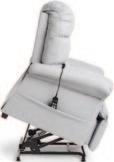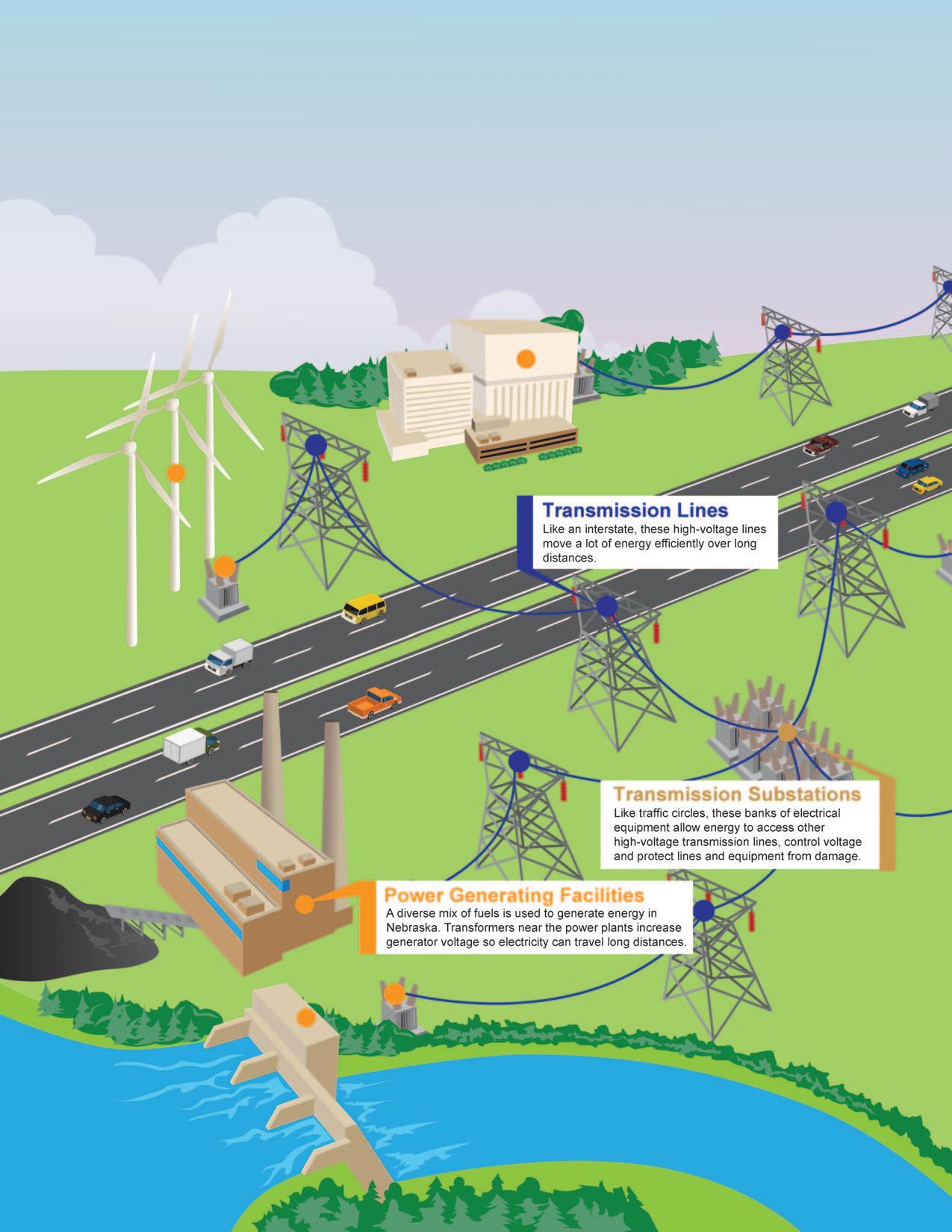


Magazine October 2022 NREA.org Inside: • The Importance of Mutual Aid • Bringing the Power to You • Reap a Safe Harvest • Insulation Made Easy Brought to you by Inside: • The Importance of Mutual Aid • Bringing the Power to You • Reap a Safe Harvest • Insulation Made Easy WILD SIDE ELECTRIC UTILITIES The of WILD SIDE ELECTRIC UTILITIES
You can’t always lie down in bed and sleep. Heartburn, cardiac problems, hip or back aches –and dozens of other ailments and worries. Those are the nights you’d give anything for a comfortable chair to sleep in: one that reclines to exactly the right degree, raises your feet and legs just where you want them, supports your head and shoulders properly, and operates at the touch of a button.
















Our Perfect Sleep Chair® does all that and more. More than a chair or recliner, it’s designed to provide total comfort. Choose your preferred heat and massage settings, for hours of soothing relaxation. Reading or watching TV? Our chair’s recline technology allows you to pause the chair in an infinite number of settings. And best of all, it features a powerful lift mechanism that tilts the entire chair forward, making it easy to stand. You’ll love the other benefits, too. It helps with correct spinal alignment and promotes back pressure relief, to prevent back and muscle pain. The overstuffed, oversized biscuit style back and unique seat design







will cradle you in comfort. Generously filled, wide armrests provide enhanced arm support when sitting or reclining. It even has a battery backup in case of a power outage.











White glove delivery included in shipping charge. Professionals will deliver the chair to the exact spot in your home where you want it, unpack it, inspect it, test it, position it, and even carry the packaging away! You get your choice of Luxurious and Lasting Brisa, Genuine Italian Leather, stain and liquid repellent Duralux with the classic leather look, or plush MicroLux microfiber, all handcrafted in a variety of colors to fit any decor. Call now!









1-888-737-1571 Please mention code 601363 when ordering. “To you, it’s the perfect lift chair. To me, it’s the best sleep chair I’ve ever had.” — J. Fitzgerald, VA 46622Because each Perfect Sleep Chair is a made-to-order bedding product it cannot be returned, but if it arrives damaged or defective, at our option we will repair it or replace it. © 2022 Journey Health and Lifestyle. 3CHAIRS IN ONE: ACCREDITED BUSINESS A+ enjoying life never gets old™mobility | sleep | comfort | safety SLEEP/RECLINE/LIFT Pictured is Luxurious & Lasting Brisa™. Ask about our 5 Comfort Zone chair. REMOTE-CONTROLLED EASILY SHIFTS FROM FLAT TO A STAND-ASSIST POSITION Now available in a variety of colors, fabrics and sizes. MicroLux™ Microfiber breathable & amazingly soft Long Lasting DuraLux™ stain & liquid repellent BurgundyTan Chocolate Blue Genuine Italian Leather classic beauty & style Chestnut Brisa™ luxurious & lasting Light GraySaddleChocolate
Telling the story of Rural Nebraska
Contents
6 The Wild Side of Electric Utilities
Staff General Manager Rick Nelson
Editor Wayne Price Editorial Assistant Tina Schweitzer
President A.C. (Pat) Hecox, Dawson Public Power District
Vice President/Secretary Greg Strehle, Cuming County Public Power District
Rural electric utilities have a long history of implementing conservation efforts to benefit Nebraska's wildlife and other natural resources, including building nesting platforms for ospreys and falcons, and modifying electrical structures to reduce potential electrocutions of birds.


14 Top 10 Reasons to Consider a Public Power Career
Treasurer
Kevin Thomas, High West Energy, Inc.
Published monthly by the Nebraska Rural Electric Association, 1244 K Street, Box 82048, Lincoln, Nebraska 68501, (402) 475-4988.
Advertising in the Nebraska Magazine does not imply endorsement for products by the Nebraska Rural Electric Association. Correspondence should be sent to Wayne Price, Editor, Nebraska Magazine, Box 82048, Lincoln, NE 68501.

The Nebraska Magazine is printed by the Aradius Group, 4700 F Street, Omaha, NE 68117. Form 3579 should be sent to Nebraska Magazine, Box 82048, Lincoln, NE 68501.
Periodicals postage paid at Lincoln, Neb. POSTMASTER: send address changes to Nebraska Magazine, 1244 K Street, Box 82048, Lincoln, NE 68501.
Publication numbers are USPS 071-630 and ISSN 01934937.
Subscriber Services: Cost of subscription for consumers of participating member-systems is $2.14 per year (17.8 cents per month), plus periodicals postage paid from equity accruing to the consumer. For nonmembers, a subscription is $10 per year or $20 for three years, plus local and state tax. Single copy, $2.50.
Departments
Editor’s Page Safety Briefs/Murphy Energy Sense
Down Home Recipes Marketplace
Rural electric utilities regularly work with other state, local and federal wildlife agencies to come up with the best ways to coexist with wildlife. See related article on Page 6. Cover photograph provided by Alexis Matsui
October 2022 3 It’s challenging work, but in addition to a paycheck, rural electric utility employees go home each night knowing they’ve helped make their communities better places to live. Discover 10 reasons why you should consider joining the rural electric utility family.
Volume 76 Number 10 October 2022
Editor’s Page
Teaching the Lesson of Energy Efficiency

Our lives are intertwined with a growing list of consumer electronics that rely on electricity. That list includes everything from smart phones to smart appliances. If you have children or grand-children around the house you probably are having to follow them around, turning off all the lights and devices they leave on.
I realize that convincing children to care about energy efficiency is a difficult task, but there might be a way you can teach your children how to save energy. It’s best to start by explaining why saving energy is important and how it could benefit the child. If they don’t understand why they should change their habits, they won’t be motivated to do so. Simply put, spending less money on the electric bill can mean more money for fun activities. That’s something any child can understand.
Because “using less electricity” is an abstract concept for small children, try to be specific about energy efficiency actions and lead by example. Children tend to learn by observing what their parents or even older siblings do. When you turn off the lights when leaving a room or unplug the phone charger once the device is fully charged, they will notice.
Teaching your children about energy efficiency doesn’t have to be a boring lecture. Try to make it fun for the greatest impact.
For younger kids, turn energy efficiency into a “treasure hunt” game to locate all the things in your home that use electricity. Depending on the age of the children, challenge them to count and group the items into categories: electronics, appliances, lights, etc. If they are old enough, have them create a list. Ask which gadgets and appliances could be turned off or unplugged to save power every day.
For older children, show them how to program the smart thermostat and appliances. Shop with them for LED lights and discuss EnergyStar-rated appliances. Show them the electric bill so they can see the costs, energy use and how their actions impact the bill.
Don’t be afraid to provide rewards for agreed upon milestones. Rewards provide positive reinforcement on energy-saving actions. The idea is to create a habit of being energy efficient. And for parents, this could mean less nagging about turning off the lights!
Teaching your children about saving energy is not only a creative way to spend time with them; it helps your home to be more energy efficient and can instill good habits that will benefit your child as they grow to adulthood.
Wayne Price
Nebraska Magazine4
Matt Fritz is the General Manager of Niobrara Valley Electric Membership Corporation, headquartered in O’Neill, Nebraska

Guest Editorial
The Importance of Mutual Aid
Mutual aid in the electrical industry. What is it? How does it work? Who gets the call? Mutual aid is just what it sounds like, electric utilities helping each other out in a time of need. In the event of a natural disaster or extreme weather event, Nebraska’s statewide organization, the Nebraska Rural Electric Association (NREA) will respond to the calls of the public power districts and electric cooperatives in the event of a natural disaster or an extreme weather event. The NREA will help the utility in need coordinate and dispatch line crews, material, and equipment from neighboring utilities to the area’s that need assistance. This can mean anything from here in Nebraska to anywhere in the United States.
In my 20-year career in the electrical industry, I have seen many challenges that Mother Nature can cause. Anything from tornados, straight winds, blizzards, ice storms, lightning storms, and floods. When one or more of these disasters hit, widespread damage and interruptions are the result. The most recent example of Mother Nature’s power is the May 2022 windstorm that affected a good portion of Nebraska. In this storm trees were up rooted, grain bins collapsed, irrigation pivots flipped, building roofs blew off and transmission and distribution poles snapped all this causing widespread power outages. Line crews and office personnel were standing by ready to take the call. Some areas and districts were hit harder than others. Those that could spare crews, material and equipment were not hesitant to provide what they can. I like to call it neighbors helping neighbors. When public power districts and electric cooperatives work together in this way, outage times shorten, and customer lives can return to normal. As you all know, almost everything is affected when the lights go out.
Public power districts and electric cooperatives are facing a new challenge when it comes to keeping the lights on in the event of a natural disaster. This challenge is supply chain. Transformers, poles, insulators, and aluminum conductors all have extensive lead times and inflated costs. Some lead times are over a year out and costs have increased 200% on certain items. This supply chain issue isn’t just in Nebraska, it is nationwide. It is hitting all utilities hard when you never know what Mother Nature is going to throw at you. It is going to take all of us working together to get through these challenges and meet the needs of our customers. Here in Nebraska, our goal is to provide low-cost reliable electric service that our customers can be proud of.
The next time you are watching the weather and things are looking bad, keep those employees at your local public power districts and electric cooperative in mind. Know we are always working together to serve the needs of our customers now and into the future. It really comes down to neighbors helping neighbors to keep the lights on.
Matt Fritz
October 2022 5
The Wild Side of Electric Utilities
Animal encounters are nothing new for rural electric utilities. Getting their start in the 1930s to serve rural areas that had no electricity, they’ve always been close to the land, and its creatures. From bears to butterflies and sheep to seabirds, public power districts and electric coops have a track record of showing they understand the importance of caring for wildlife.
Janelle Lemen, regulatory director for environmental policy at the National Rural Electric Cooperative Association (NRECA), describes how rural electric utilities across the country take actions like building nesting platforms for ospreys and falcons, and modifying electrical structures to reduce potential electrocutions of birds. They coordinate those efforts nationwide though NRECA’s membership, since 1989, in an organization called the Avian Power Line Interaction Committee.
Electric utilities also regularly work with other state, local and federal wildlife agencies to come up with the best ways to coexist with wildlife.

Lemen says, “Electric utilities have a long history of implementing conservation efforts to benefit America's wildlife and other natural resources.”

One part of that history is an annual week-long Pollinator Power Party. Electric utilities know a lot of us love butterflies and bees, and that both are essential to the ecosystems that pollinate plants. So, several electric co-ops have become part of a group called the Pollinator Partnership to increase awareness of bee and butterfly habitats.
A more direct interest between electric utilities and wildlife comes in the form of protecting birds from highvoltage equipment, both for the birds’ own safety and to keep animal electrocutions from causing power outages.
Electric utilities in several states, including Nebraska, have built platforms to keep ospreys and other birds from nesting on power lines. Wheat Belt PPD in Sydney, Neb., Roosevelt PPD in Mitchell, Neb., and Midwest Electric Cooperative Corp. in Grant, Neb. have put up such platforms for osprey in their areas.
“When we have found ospreys building nests on our
power lines, we have worked with Fish & Wildlife to build a new perch for them to nest on and remove the nest from our pole to keep the ospreys out of harm’s way and prevent outages,” said Jayson Bishop, Midwest ECC Manager.
Ospreys are piscivorous (fish-eating) raptors that migrate through Nebraska in spring and fall. For much of recent history, this species nested west, north and east of Nebraska. However, ospreys are increasing in the United States and in 2008 a pair attempted to nest near Winter's Creek Lake, Scotts Bluff County. Other osprey pairs have attempted to nest in the Panhandle since 2008, including near Lewellen, Garden County.
Nebraska Magazine6
As solar energy use grows across the country, several electric utilities are getting the grass under photovoltaic panels trimmed by goats and sheep. Photograph by Alange’ Jacobs
 by Paul Wesslund
by Paul Wesslund

“It is nice to see ospreys increasing and nesting in Nebraska, but this species also presents challenges because they like to nest on utility structures (e.g., power line pole crossbars),” said Joel Jorgensen, Nongame Bird Program Manager, Nebraska Game and Parks Commission. “This creates problems for electric utilities and their customers because ospreys pile sticks on utility structures.”
A pile of sticks and other materials (e.g., bailing twine) on power lines can result in power outages and even fires once electrical lines connect and arc. This is bad for people who lose service and utility lineman that have to keep going out to do repairs. It is also not good
Top: An osprey nest platform being moved into place at Clear Creek Wildlife Management Area by personnel from Wheat Belt Public Power District. Photograph provided by Earl Reilly

Bottom: Midwest Electric Cooperative Corporation crews constructed an osprey nest platform. Photograph provided by Jayson Bishop

for ospreys and their young. Ospreys and their nests are protected by state and federal law, which presents legal hurdles for simply removing a problem nest. And it’s not always the electric utilities protecting animals. Sometimes the critters help out the electric utilities.
As solar energy use grows across the country, some electric utilities are getting the grass under photovoltaic panels trimmed by goats and sheep. Well, maybe not goats so much. With electric utilities finding economic and environmental benefits to grazing under and around solar panels, the National Renewable Energy Laboratory actually conducted a study called Solar Sheep and Voltaic Veggies: Uniting Solar Power and Agriculture. Among its conclusions: “Sheep have often proven to be the best tenants of the land. Horses can be picky about what they eat, cows are large and require a lot of space, and goats tend to chew on wires and climb on panels.”

October 2022 7
Bringing the Power to You
From the power plant to your home or business, the electricity we use every day travels through a complex system of poles, wires, and substations before it provides heat and light to your home. Nebraska incorporates a diverse mix of resources into its generation portfolio which include the use of coal, nuclear, hydroelectric, natural gas, and renewable energy resources.
Once the electricity is generated, its voltage is increased by a transformer and it begins its journey on high voltage transmission lines. In Nebraska, these lines carry as much as 345,000 volts of electricity. Next, the electricity flows

Nebraska Magazine8
through a substation where the voltage is reduced, allowing the electricity to flow on to smaller distribution lines. These distribution lines carry electricity closer to its destination where once again the voltage is stepped down by a transformer to the 120 volts that you use in your home.

Delivery of electricity is a complex process that requires constant monitoring so that when you hit the light switch, electricity is delivered at the speed of light from the generation plant and into your home. To avoid overloading the system, electric generation has to be balanced simultaneously to match consumer needs. At any given moment, the electricity generated from power plants has to match consumer demand. Too much or too little generation could result in blackouts. This means that every minute of every day your electric suppliers are monitoring the electric generation and delivery process to ensure you receive a reliable electric supply.
Nebraska
miles of powerlines across the
October 2022 9
Rural Electric Association member-systems maintain more than 92,000
state.
Defending Our Nation’s Electric Grid From Cyberattacks
by Justin Luebbert
As cybersecurity threats continue to grow both at home and in the workplace, it’s important to know what we can do as individuals, how we can work with others and measures we can take to reduce our risk of cyber threats.
October is Cybersecurity Awareness Month––but good cyber hygiene should be practiced year-round. As the grid evolves and new technologies emerge, this creates additional opportunities for threat actors to target our systems.
Public power districts and electric cooperatives are coming together to fight back and add resiliency to the electric grid. When it comes to cybersecurity, cooperation happens in a multitude of ways.
Public power districts and electric cooperatives are working together and with their local Generation and Transmission (G&T) utilities, statewide organizations and the National Rural Electric Cooperative Association (NRECA), the national trade association for public power districts and electric cooperatives. Together, they’re leading efforts to establish relationships, provide tools, share resources and training information to harden and improve the overall cyber landscape.
You can help too. Good cyber hygiene is equally important at home and in our personal lives. Just like grid technology continues to expand, so does the connected home. With smart (internet-connected) technologies integrated into many of our homes, whether it be a smart speaker or a connected appliance, it’s essential to take steps to protect our devices and personal data.
Here are a few cybersecurity tips you can implement at home:
• Enable multi-factor or two-factor authentication for your online accounts. This extra layer of security allows websites and applications to confirm you’re really who you say you are. The additional authentication may
come in many forms, including a confirmation text code on your phone, an email or even a separate authenticator app. By adding this second step, you’re making it a lot harder for hackers to access your accounts. A Virtual Private Network (VPN) can help you secure sensitive online connections.
• Use secure passwords. This means using unique passwords for all your accounts and ensuring they are at least 15 characters long. Randomly generated passwords or passphrases are typically more secure. You might also consider using some type of password manager. In addition to suggesting new, strong and unique credentials for every login, many password managers will let you know if your existing passwords are weak, reused or have been associated with a data breach so you can take action immediately.
• Think before you click. Be careful when clicking links or opening attachments. This is one of the most important ways to protect yourself against scammers and hackers. If you receive a text message or email that seems too good to be true or threatens negative consequences for not taking immediate action or displays a sense of urgency, take extra precaution. If an email looks like it came from a friend or co-worker but it seems odd, pick up the phone and check with the person before opening any links or attachments. In many instances, their email account might have been hacked.
Remember, it’s important to practice good cyber hygiene at home, in the workplace and even on the go. Be vigilant as you connect to outside networks and carefully read emails before clicking or opening links and attachments. Consider using a virtual private network (VPN), which encrypts your online activities while you’re working on the go or even at home. A VPN adds a layer of privacy protection to your online interactions by routing your traffic through an encrypted connection.
We all have a part to play in combatting cyber threats. Rural electric utilities and their local and national partners will continue working together to advance cybersecurity defenses for all consumer/members and the local communities they serve.
Nebraska Magazine10
OCTOBER IS NATIONAL CYBERSECURITY AWARENESS MONTH
We all share responsibility for our organization’s online safety and security, and YOU are our first line of defense.
Think Before You Click
• Always hover over a link first to be sure it is safe.
• Report suspicious emails or emails from an unknown sender to your spam filter and delete them from your inbox.
Defend Your Computer
•
The best defense against viruses, malware and other online threats is keeping your equipment up to date.
• Work with our IT staff (or provider) to keep your software, including your web browser, and operating systems current.
Lockdown Your Log-in
• Create long and unique passwords. Use familiar phrases or song lyrics you’ll remember.
• When possible, use 2-factor authentication as a second layer of defense.
• Change passwords regularly, and do not share them.
Watch for Red Flags to Identify Potential Phish Attacks
• Phishing attempts seek to steal or compromise data and will often mimic a known sender.
Look for red flags:
1. the email is unexpected;
2. there is a sense of urgency conveyed;
3. there is an offer that seems too good to be true; and/or
4. there are typos and misspellings.
Protect Sensitive Information
• Use encryption to protect sensitive data.
• Limit the spread of any attack by only accessing files and folders you need.
• Do not put confidential information in emails, or instant and text messages.
Practice Good Cyber Hygiene On the Go
• Treat all public Wi-Fi networks as a security risk, and don’t make financial or other sensitive transactions over public networks.
Want more tips to improve your cyber hygiene? Visit www.staysafeonline.org.
Give your HVAC system a tune-up before winter

This summer has been another extremely hot one. Heat from the sun not only drives up the air temperature, it warms the surfaces of our homes and will move to the interior via convection, conduction and radiation. The inside temperature of a home can quickly match the outdoor temperature due to this law of nature.
But thanks to air conditioning, we can create comfort within our homes and catch a break from this byproduct of summer. However, the cool, crisp air we enjoy by this modern convenience causes the meter to chalk up additional kilowatt-hours. Here are some smart energy tips to help increase your comfort while managing your electric bill:
• Although this may sound like a broken record, I cannot express enough the importance of a periodic heating, ventilation and air conditioning (HVAC) system tune-up. Manufacturers’ suggested timeframes might vary, but it’s probably time if you cannot remember your last tune-up. Also, be sure to ask the contractor to inspect the ductwork as well. An HVAC system that operates at optimum performance will provide the comfort you expect, plus you’ll be using energy wisely while managing the kilowatts required for operation. As a reminder, our HVAC systems generally make up 50 percent of the total electric bill.
• Perhaps your HVAC unit is on its last leg and you’ve been contemplating installing a new system. The good
news is today’s air conditioners and heat pumps are even more energy efficient than their predecessors. If replacement is in your future, be sure to look for a contractor who understands building science and will run a computer-generated load calculation for your home. The software used by HVAC processionals removes any guesswork and accurately sizes the unit required to heat and cool your home. A properly sized system provides optimum comfort while using less energy to operate.
• Now is the time to replace the HVAC system returnair filter. Many homes have more than one, so be sure to change all of them. Clogged filters inhibit proper airflow and can cause premature wear and tear on your system. I suggest changing them monthly or as needed. Be sure to ask your HVAC professional if you plan to use HEPA or heavy-pleated filters to make sure they will work with your system.
• If you have a fireplace or woodstove, make sure to close the damper. An open damper is similar to having an open window. Speaking of windows, if your home has double-hung (windows that open at both top and bottom) construction, make sure both top and bottom sashes are closed, and locked. If left unlocked, it’s not uncommon for the top sash to drop, or open at the top.
• If you have an older home, some insulating products are prone to settle. Have an insulation contractor inspect the insulation level in your attic. If necessary, an additional layer of cellulose insulation applied over the existing insulation will thwart unwanted heat gain in the summer and keep your home warmer in the winter.
Nebraska Magazine12
Controlling Appliances from Mobile Devices
By Brian Sloboda
Today’s world offers smart phone apps for anything and everything. Some apps let you chase imaginary Pokémon around parking lots, while others allow you to control your vast financial empire with merely a few clicks, swipes and shakes.
It should be no surprise that a growing number of household appliances are app enabled. Most of the apps exist to make your life more convenient, assuming keeping your eyes glued to a small screen is your definition of convenience. But some of these apps can actually help you save energy and make your home more comfortable.
Manufacturers are now adding communication modules inside home appliances. For around $130, you can purchase a Crock-Pot that will communicate with your smart phone. If you are late coming home, you can adjust the heat setting and achieve the perfect pot roast.
Some companies are selling electrical outlets that include communication modules. These modules often use Wi-Fi to communicate simple messages to a home’s wireless network. What the messages are will vary from device to device. Typically, the system will allow you to monitor energy consumption, turn devices on and off and change the setting on your thermostat.
The bulk of any energy savings will come from the ability to remotely control your HVAC system’s thermostat.
Apps associated with Wi-Fi controllable thermostats are often easier to use. Thermostats from companies such as Nest, Honeywell and Ecobee allow you to adjust your home’s temperature from your phone. This comes in handy when you forget to turn the air conditioner off while on vacation, or when you want to heat your living space before returning home. These thermostats are also capable of learning your schedule and can provide energy savings by turning the systems back when no one is home. Studies have shown these smart thermostats tend to perform as advertised.

App-enabled appliances won’t be right for every homeowner. It depends on a variety of factors, and many questions should be answered before going down this road:
1. What are my goals? Do I want home security, energy savings or just the latest app technology?
2. Do I have broadband internet in my home? Many of these systems require a broadband internet connection to work properly.
3. What appliances and devices in my home do I want to control? Thermostat, doors, lighting, refrigerator?
4. Can I afford the additional cost, and is it worth it to me?
5. What appliances need replacing and does an app really
Smart appliances won’t cook dinner with the mere push of a button, but many will allow you to see what is going on at home, who is home and even turn lights and air conditioning on and off.
make sense for that appliance? One appliance manufacturer says consumers can turn their oven on from their phone while driving home. Will you really use this feature?
6. Who owns the data collected from your appliances, and how will they use it?
So far, none of these smart appliances will cook dinner with the mere push of a button, but the devices do allow you to see what is going on at home, who is home and even turn lights and air conditioning on and off. For some, these gadgets and apps are cool and worth the additional expense. For others, it’s just one more piece of technology that can break or go unused while trying to rush kids off to baseball practice.
To learn more about app-enabled appliances and how to save energy, contact the energy experts at your local electric utility.
October 2022 13
Top 10 reasons to consider a public power Career
There are many ways to earn a paycheck, but some are more rewarding than others. Here are 10 reasons to consider joining the rural electric utility family.
The electricity industry is at the leading edge of a global energy revolution. Rapid advances in renewable generation, energy storage and smart grid technologies will change the way we use electricity. If you work at a rural electric utility, you can be part of this oncein-a-lifetime industry transformation.
8
Support a clean environment
Electricity is one of our cleanest energy sources, and as technology improves, electric cars, nextgeneration heating and cooling systems, home automation and other forms of environmentally beneficial electrification will reduce our reliance less efficient forms of energy.
9
Business on a human scale
Public power districts and electric cooperatives hold themselves to the highest standards of professionalism and integrity while still maintaining a close-knit, familyfriendly working environment. Decisions are made locally by managers who know employees by name, not halfway across the country in some corporate headquarters. Their smaller size and local control also gives rural electric utilities more flexibility to innovate and try new ideas to improve the service they provide.
10Tech-focused
Nebraska Magazine14
Retirement security
It might seem a long way off today, but we all need to plan for retirement.
Rural electric utility employees deliver a valuable service to their communities, and they’re rewarded for that dedication with outstanding retirement benefits. Many utilities offer both a 401(k) plan and a defined-benefit pension plan.
1
Build a stronger community
Safe, reliable and affordable energy is critical to the health and prosperity of a community.
Public power districts and electric cooperatives power our homes, schools, farms and businesses, and keep rural America connected to the global economy.
2
Competitive pay
You won’t get rich working for your local electric utility, but you’ll enjoy excellent pay and benefits that can help you and the people you love achieve the American dream.
National reach
Rural electric utilities serve 47 states and 56 percent of our nation’s landmass. So whether you want to stay in your hometown or explore another part of the country, odds are good that there will be a rural electric utility nearby.
5
Stability
Electronics play a critical and growing role in our daily lives, and as our reliance on technology increases, so too will our demand for electricity. As long as we need electricity, we’ll need workers to ensure it is safe, reliable and affordable.
Principles: not profit
3
When you work for a public power district or electric cooperative, you’re not helping some Wall Street elite get richer. You’re working to serve your friends, family and neighbors who collectively own the utility.
Join a global movement
As a member of the rural electric utility family, you’re part of something much larger than yourself. The cooperative movement represents a human-centered, ethically driven way of doing business. More than 250 million people around the world earn their living working in cooperatives, and the cooperative economy generates approximately $2.5 trillion in global economic activity each year.
October 2022 15
4
6
7
Safety Briefs

Take Time to Reap a Safe Harvest
Each year, dozens of farm workers are killed and hundreds are injured in accidents involving power lines and electrical equipment.
Things people see every day can fade from view and in the busy-ness of harvest time, it’s easy for farm workers to forget about the power lines overhead. But failure to notice them can be a deadly oversight.
Review with all workers the farm activities that take place around power lines. Inspect the height of farm equipment to determine clearance. Keep equipment at least 10 feet away from power lines –above, below and to the side – a 360-degree rule.
Always lower grain augers before moving them, even if it’s only a few feet. Variables like wind, uneven ground, shifting weight or other conditions can combine to create an unexpected result Also use extreme caution when raising the bed of a grain truck.

Farm workers should take these
steps to ensure a safer harvest season:
• Use care when raising augers or the bed of grain trucks around power lines.
• Use a spotter when operating large machinery near power lines. Do not let the spotter touch the machinery while it is being moved anywhere near power lines.
• As with any outdoor work, be
careful not to raise any equipment such as ladders, poles or rods into power lines. Remember, nonmetallic materials such as lumber, tree limbs, ropes and hay will conduct electricity depending on dampness, dust and dirt contamination.
• Never attempt to raise or move a power line to clear a path!
• Don’t use metal poles to break
Nebraska Magazine16
up bridged grain inside bins. Know where and how to shut off the power in an emergency.
• Use qualified electricians for work on drying equipment and other farm electrical systems.

Operators of farm equipment or vehicles must also know what to do if the vehicle comes in contact with a power line: Stay on the equipment, warn others to stay away and call 911. Do not get off the equipment until the utility crew says it is safe to do so.
If the power line is energized and you step outside, touching the vehicle and ground, your body becomes the path and electrocution is the result. Even if a power line has landed on the ground, the potential for the area nearby to be energized still exists. Stay inside the vehicle
unless there’s fire or imminent risk of fire.

If this is the case, jump off the equipment with your feet together, without touching the ground and vehicle at the same time. Then, still keeping your feet together, hop to safety as you leave the area.
Once you get away from the equipment, never attempt to get back on or even touch the equipment. Some electrocutions have occurred after the operator dismounts and, realizing nothing has happened, tries to get back on the equipment.
It is very important that all farm workers and seasonal employees are informed of electrical hazards and trained in proper procedures to avoid injury.
Source: SafeElectricity.org


October 2022 17
Energy Sense
by Miranda Boutelle
Insulation Made Easy
: What cost-effective improvements will make my home comfortable year-round?
: It isn’t pretty, but insulation and air sealing typically provide the biggest bang for your buck when it comes to home energy efficiency improvements. When installed together, they can save you money and make a big difference in comfort and energy use.
Insulation Rating
Insulation is rated in R-value. The R stands for resistance to heat transfer. The higher your R-value, the slower the heat transfer, or less wasted energy. There are several different types of insulation, including fiberglass batts, blown fiberglass, cellulose and foam. Each has its own R-value listed on the packaging. To determine the R-value of your existing insulation, multiply the number of inches by the R-value per inch for the type of insulation.
Insulation level recommendations are based on your geographic location. Generally, the colder the climate, the higher the recommended R-value.
Where to Insulate
The typical locations for insulation are the attic, walls and floor. If you have a forced-air heating or cooling system, your ductwork should be insulated, too. You want a consistent thermal barrier around your home for maximum efficiency. A bonus to insulation is it can reduce noise from the outside of your home.
Attic insulation minimizes energy waste and can help maintain a more consistent temperature throughout your home. Combined with air sealing, it also can prevent ice dams from forming on your roof in colder climates.
Attics can be insulated using batts or
blown-in insulation. Recommend R-values range from R30 to R-60. If you use your attic for storage, you can build a raised platform with room for insulation underneath. Add insulation and weatherstripping to access doors or hatches.

Exterior walls and walls separating heated and unheated areas of the home (garages or enclosed porches) should be insulated to an R-value ranging from R-13 to R-21, based on your location and wall construction.
Wall insulation can be installed during construction or a remodel. If your home wasn’t insulated when it was built, you can have the insulation blown in by a contractor. Blown-in options include cellulose, fiberglass and foam.
Your home should also be insulated between the floor and crawlspace or unheated basement. If your basement is heated, install insulation in the box sills—the area between the foundation floor of the home’s main level.
Consider building and insulating the exterior walls in the basement or installing foam insulation on foundation walls. Check your local building code requirements.
Recommended R-values for floor insulation range from R-13 to R-30. Also insulate heating and cooling ductwork located in unconditioned spaces to prevent energy waste.
Importance of Air Sealing
Think of insulation as a cozy sweater and air sealing as a
Nebraska Magazine18
Q A
windbreaker for your home.
You know that cozy sweater is no match for winter winds, so you need an extra layer to stop it from ripping through. The same goes for your home.
Air sealing prevents drafts and air infiltration from outside. It can improve efficiency, comfort and indoor air quality.
Air sealing can be done as a DIY project, but it is challenging to pinpoint and properly seal air leaks. Consider hiring a contractor to complete a blower door test and seal leaks.
Typically, air sealing is done around plumbing and electrical penetrations with spray foam or caulk. If using spray foam around gas appliances, temporarily turn off pilot lights. Spray foam is extremely flammable.
Sheet metal and high-temperature heat-resistant caulk should be used to seal gaps between framing, chimneys and metal flues.
DIY Considerations
If you are considering a DIY approach, protect yourself when going into spaces with insulation. Wear a properly fitted mask or respirator. Wearing a Tyvek suit and gloves also is recommended. Kneepads can come in handy and make the crawling more bearable.

If you are planning a DIY approach for air sealing, do your research about best practices for the proper home ventilation. Before going the DIY route, contact two or three local contractors for a project estimate. Sometimes the contractor can get cheaper bulk pricing on insulation.
Making insulation and air sealing a priority adds comfort, efficiency and savings to your home.
Suicide Prevention Hotline Gets a New Number
Every 11 minutes, someone dies by suicide. Now those contemplating suicide can call “988” for help.
The new National Suicide Prevention Lifeline number for mental health crises is similar to the 911 number for medical emergencies. Because callers only have to remember three digits, the Federal Communications Commission notes it will be easier for Americans in crisis to get the help they need.
Though the National Suicide Prevention Lifeline has been
around since 2005, previously callers had to phone a 10-digit number (1-800-273-8255) to reach a network of trained crisis counselors. Callers to the new hotline number will be redirected to the 800 number.
Since 2008, suicide has been ranked as the 10th leading cause of death in the United States. According to the American Foundation for Suicide Prevention, it is the 13th overall leading cause of death in Nebraska. Suicide is the 2nd leading cause of death in people ages 10-44 in Nebraska.
October 2022 19
Down Home Recipes
Take Your Cooking Skills to the Next Level
For home chefs looking to take their cooking skills to the next level, it all starts with a little inspiration and a few new skills. Turn family meals into extravagant adventures, take backyard barbecues to new heights and impress friends and neighbors with pitmaster-worthy recipes.
In fact, it can be as easy as turning on the TV. From beef ribs and barbacoa to curried brisket rice and pho rub beef belly spring rolls, viewers are in for a treat by tuning into season 3 of “BBQuest: Beyond the Pit,” a video series that dives into the long-held traditions, new flavors and everyday inspiration that make Texas barbecue legendary.
The show follows four themes that capture the essence of Texas barbecue: legacy and tradition; creativity and innovation; Texas trailblazers; and family and community.
You can bring barbecue flavors home and cook like a pitmaster with dishes recreated from the series and developed by “Hardcore Carnivore” cookbook author Jess Pryles, including Smoked Chuck Beef Ribs, Grilled Jalapeno Cheddar Meatballs and Szechuan Skirt Steak with Crispy Rice.
Learn more about the show and find inspiration to bring the taste of barbecue to your kitchen at BeefLovingTexans.com.
Szechuan Skirt Steak with Crispy Rice

2 teaspoons Szechuan peppercorns
1 teaspoon five spice powder
1 teaspoon kosher salt
1 skirt steak or bavette steak (about 1 pound)
1/4 cup vegetable oil, divided
2 teaspoons milk or cream
2 cups cooked white rice sesame seeds (optional) scallions, thinly sliced (optional) cucumber, sliced (optional) cilantro leaves (optional)
In skillet over low heat, toast peppercorns until fragrant, swirling in pan to keep from burning, about 2 minutes. Allow peppercorns to cool slightly then add to spice grinder or mortar and pestle with five spice and salt. Crush until fine powder forms.
Pat skirt steak with paper towel to remove moisture then season well with Szechuan salt on both sides.
Place skillet over high heat then add 1 tablespoon oil. When skillet is hot, add skirt steak and cook 5 minutes per side for medium-rare or medium doneness (135150 F), turning occasionally. Remove steak from skillet then tent with foil to rest 3 minutes. Temperature will rise about 10-15 F to reach 145 F for medium-rare; 160 F for medium.
Lower heat to medium-high then add remaining oil and milk or cream. Add rice, pressing down gently with large spoon to form large, flat disc covering entire base of pan. Season with Szechuan salt, if desired, then lower heat to medium and cook 10 minutes until grains begin to turn brown and become crisp on bottom. Break up rice in pan to mix soft and crispy grains.
Slice skirt steak across grain.
To serve, place rice in two bowls. Layer with sliced skirt steak. Sprinkle with sesame seeds and chopped scallions then place cucumber and cilantro on top, if desired.
Nebraska Magazine20
Grilled Jalapeno Cheddar Meatballs

1/2 cup tortilla chips, crushed
3/4 cup milk
2 pounds ground beef
3 fresh jalapenos, seeded and finely diced
1 block (8 ounces) cheddar cheese, finely diced
1 tablespoon paprika
2 teaspoons garlic powder
2 teaspoons kosher salt
Place crushed tortilla chips in large bowl. Add milk and allow chips to soften about 10 minutes.
After milk is absorbed, add beef, jalapenos, cheese, paprika, garlic and salt. Mix well to combine then scoop approximately 1/3-1/2 cup of mixture to form meatball; repeat with remaining mixture.
Place meatballs on plate or tray and refrigerate 30 minutes to firm.
Heat grill to medium for two zone cooking.
Place meatballs on indirect heat side of grill away from coals or lit burner; close lid. Grill 25-35 minutes, or until meatballs reach 165 F internal temperature on meat thermometer.
Remove meatballs from grill and cool slightly before serving.
Reader Submitted Recipes
2 tablespoon olive oil
1 lb. sweet Italian sausage
1 onion, chopped
3 cloves garlic, mashed
1/2 teaspoon dried oregano
1/2 teaspoon salt
1 1/4 cup ziti or Mafalda pasta
1 (28 oz.) can crushed tomatoes
1 (15 oz.) can tomato sauce
8 oz. whole-milk ricotta cheese
4 oz. mozzarella cheese, sliced or shredded
2 tablespoon fresh basil, thinly sliced
Make aluminum foil collar for slow cooker by folding 2 (18 inch long) pieces of foil to make 2 (18 by 4 inch) strips. Line perimeter of slow cooker with foil strips and spray with pan spray.
Heat 2 tablelspoons olive oil in Dutch oven over medium-high heat until just smoking. Cook sausage, breaking up pieces with spoon, until well browned, 6 to 8 minutes. Add onion and cook until lightly browned about 5 minutes. Stir in garlic, oregano, salt and pepper and cook until fragrant, about 1 minute.
Reduce heat to medium-low. Add Ziti and cook, stirring constantly, until edges of pasta become translucent, about 4 minutes. Off heat, stir in crushed tomatoes and tomato sauce, scraping up any browned bits. Transfer mixture to prepared slow cooker. Cover and cook on low until pasta is tender, about 4 ½ hours. (Over-cooking will cause pasta to bloat) If it looks too dry, add a little water and stir in.
Using tongs, remove foil collar from slow cooker and stir gently to redistribute pasta. Dollop ricotta over pasta mixture, and top with mozzarella cheese. Cover and let sit for 25 minutes longer to let cheeses melt. Garnish with fresh basil.
Charlene Dolezal, Julesburg, Colorado
Granny Key’s Chili Sauce
13 lbs. of tomatoes, peeled and cut in small pieces
3 onions, quartered
4 green peppers, cut in small pieces
4 red peppers, cut in small pieces
1 1/2 cups white vinegar
1 tablespoon whole allspice
2 sticks cinnamon
1 tablespoon whole cloves
1 cup sugar
3 tablespoons salt
In a large pot, combine tomatoes, onions, peppers and one cup of vinegar. Tie spices loosely in a cheesecloth bag and cook with vegetables. Simmer for an hour. Remove spice bag. Add reserved vinegar, sugar and salt. Boil rapidly for 5 minutes, stirring constantly. Pour into hot, clean jars and seal. My note: For safety, I suggest processing in a hot water bath for 10 minutes. This is my husband’s grandmother Lucelle Key’s delicious recipe. It’s a favorite on hot dogs, burgers and eggs.
Marilyn Schumacher, Chadron, Nebraska
Slow Cooker Ziti
October 2022 21
Get your FREE Information Kit




Product not available in all states. Includes the Participating (in GA: Designated) Providers and Preventive Benefits Rider. Acceptance guaranteed for one insurance policy/certificate of this type. Contact us for complete details about this insurance solicitation. This specific offer is not available in CO, NY; call 1-800-969-4781 or respond for similar offer. Certificate C250A (ID: C250E; PA: C250Q); Insurance Policy P150 (GA: P150GA; NY: P150NY; OK: P150OK; TN: P150TN). Rider kinds: B438, B439 (GA: B439B). 6208-0721


Nebraska Magazine22 Marketplace
DENTAL Insurance If you’ve put off dental care, it’s easy to get back on track. Call Physicians Mutual Insurance Company now for inexpensive dental insurance. Get help paying for the dental care you need. Getting back to the dentist couldn’t be easier! CALL TODAY 1-855-640-9264 Dental50Plus.com/electric * Cannot be combined with any other offer. For a limited time only. Foundation Repair Basement Waterproofing Nasty Crawl Spaces Sinking Concrete INCREDIBLE SAVINGS! ANY PROJECT * Mention Promo Code ‘GET250’ WE CAN FIX IT! SCHEDULE YOUR FREE INSPECTION CALL NOW 866-338-4298 Foundation issues? Sinking concrete?
ELECTRIFY AND SAVE
WAYS TO SAVE AND IMPROVE ENERGY EFFICIENCY IN YOUR HOME


+ SWITCH TO A HEAT PUMP WATER HEATER (HPWH)
HPWHs are 350% more efficient than a traditional water heater and cost less to operate. HPWHs use electricity to transfer heat from the air into the water, instead of using combustion to generate heat, making HPWHs a safer alternative.
+ INSTALL LED LIGHTING
LED lightbulbs consume 80% less energy than incandescent bulbs and can last 10 to 25 times longer. Unlike incandescent bulbs, which release 90% of their energy as heat, LEDs are far more energy-efficient with very little heat.
+ SAVE WITH AN AIR-SOURCE HEAT PUMP
The newest air-source heat pumps can be up to 300% more efficient than electric baseboard heat. They work in cold weather and can reduce your propane usage by 80% or more.
+ UPDATE YOUR ELECTRICAL PANEL
When increasing your home’s energy efficiency, keep in mind that it may require a service panel upgrade. As you receive quotes for electrical equipment always be sure to ask for a load calculation to ensure your electrical panel can handle the new equipment.
To learn more about rebates and incentives for electrification programs, contact your local co-op or public power district. Visit us at www.tristate.coop/BE
 Tri-State is a not-for-profit power supplier to cooperatives and public power districts in Colorado, Nebraska, New Mexico and Wyoming.
Tri-State is a not-for-profit power supplier to cooperatives and public power districts in Colorado, Nebraska, New Mexico and Wyoming.




























































 by Paul Wesslund
by Paul Wesslund


























 Tri-State is a not-for-profit power supplier to cooperatives and public power districts in Colorado, Nebraska, New Mexico and Wyoming.
Tri-State is a not-for-profit power supplier to cooperatives and public power districts in Colorado, Nebraska, New Mexico and Wyoming.



